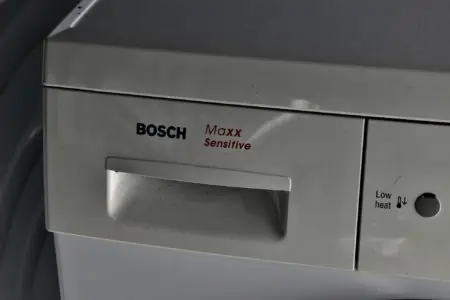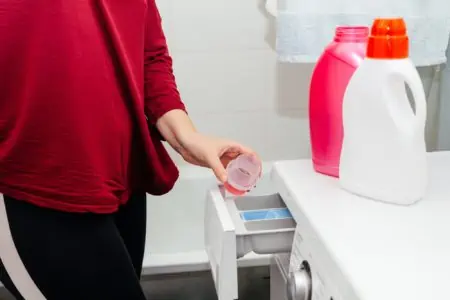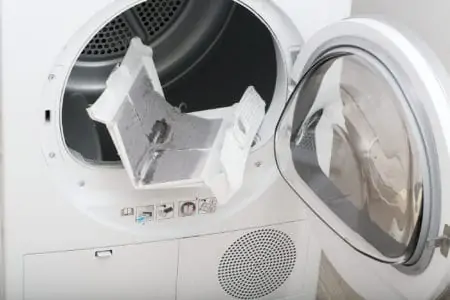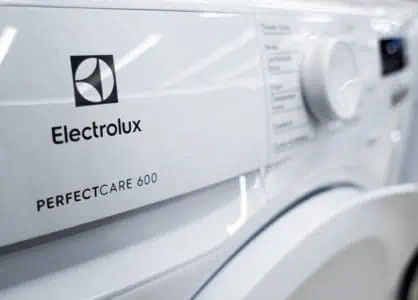Did you know that a pillow collects a bunch of nasties every night? Think dirt, saliva, sweat – even mold and bacteria. If your pillow is smelly or stained, it’s time to wash it.
We won’t lie, washing pillows isn’t the most exciting task. But the good news is, you can wash them in your machine!
We’ve tried it, and it works a treat. Just note that they do take a while to dry. Let’s get into our six-step method for how to wash pillows in the washing machine.
Key Takeaways
- Wash pillows every 3-6 months to prevent mold, mildew, and odors.
- Machine washable pillows include polyester, down feather, and cotton.
- To wash pillows in a washing machine, fluff, soak, add detergent, and set to a warm, gentle cycle.
- Dry pillows in a dryer with towels and tennis balls or dryer balls, and fluff up every hour until fully dry.
How Often Should You Wash Pillows?
We recommend washing your pillows every three to six months. Leaving it longer than six months can increase the chances of mold and mildew on your pillow.
If you notice bad odors or stains, or your skin is irritated every night, wash your pillow right away.
Can You Wash Pillows In The Washing Machine?
Yes, you can wash pillows in the washing machine. But not every type of pillow is machine washable.
We’ll break down which are and which aren’t, so that you don’t damage your precious pillows.
| Pillow Material | Washing Machine or Hand Wash? |
| Polyester | Machine wash on a gentle setting, warm water, with minimal mild liquid detergent |
| Down Feather | Machine wash on a gentle setting, warm water, with mild detergent. Add an extra rinse cycle. |
| Memory Foam | Hand wash spot cleaning only |
| Buckwheat | Remove hulls and handwash only |
| Cotton | Machine wash on a gentle, setting, warm water, with mild detergent |
| Latex | Hand wash spot cleaning only |
| Decorative Pillows and Cushions | Hand wash or machine wash according to the care label |
| Wool | Cold delicate cycle, extra rinse cycle, wool detergent |
Expert Advice
Always read the care label. Your manufacturer might have different instructions than what’s generally recommended.
How to Wash Pillows In The Washing Machine
Let’s get into our favorite method for washing pillows in a washing machine. This easy method can get your pillows fresh and fluffy again, with minimal work from you.
We’ll also show you how to dry the pillows so that you can use them again ASAP.
Before we get started, note that we do not recommend using a top loading washing machine with an agitator. The central agitator can damage pillows. Instead, use a front loader machine or a top loading machine without an agitator.
If you do not have one of these machines at home, you can follow these steps at your local laundromat.
- Time: 2 hours (plus drying time)
- Difficulty: Easy
What You’ll Need:
- Bathtub or shower
- Gentle laundry detergent (liquid for polyester and wool detergent for wool pillows)
- Mesh laundry bag for decorative pillows
- Two dry towels
- Two tennis balls or dryer balls
- Washing line (optional)
- Clothes pegs (optional)
1. Fluff and Soak
Before washing the pillows, give them a good fluff to remove excess dust and debris. After this, soak them in a bathtub or shower. When they’re wet, they will absorb detergent better and come out much cleaner.
2. Put Pillows in the Machine
We recommend putting only two pillows in the machine at once. If you put in more, it will prevent the detergent and water from washing the pillows properly. However, if you only put in one pillow, it will move around a lot which can damage the pillow.
So put two pillows in the machine, laying them next to each other around the perimeter of the drum, rather than stacked on top of one another. They will move during the cycle, but that’s okay.
3. Add Detergent and Set the Cycle
You can use liquid or powder detergent for most machine-washable pillows. If you use powder detergent, dissolve it in warm water before adding it to the dispenser. This ensures that it’s fully dissolved and won’t leave residue on your pillows.
Remember to use only one tablespoon of liquid detergent for polyester pillows. These pillows are more absorbent, so they don’t need as much detergent.
Set the cycle to a warm, gentle one. Add an extra rinse if you’d like. This is important for down and feather pillows to ensure that all of the detergent residue is gone from the pillow.
For decorative pillows, put the pillow in a mesh laundry bag to ensure that it’s safe. You don’t want sequins getting ripped off during the cycle!
Begin the cycle.
Once the cycle is finished, check that the detergent residue is all gone. If not, run another rinse cycle.
4. Dry in the Machine
If your care label says it’s safe in the dryer, pop the pillows in there with a couple of dry towels. These towels will absorb the water to dry the pillows quicker.
Add two tennis balls or dryer balls. These will ensure that your pillows get fluffy again, which you’ll be glad about later that night!
Set the machine to warm air for one hour. For down feather pillows, use a no-heat or cold air cycle.
Check on the pillows every hour. Fluff them up and switch out the towels for dry ones if necessary. Continue until dry.
Disclaimer: When we did this in our dryer, the pillows still weren’t fully dry after a few hours. We have a spacious, high-quality dryer, but it struggled to dry feather pillows thoroughly. Eventually, we hung them on the line, and a couple of days later (yes, days!), they were dry. So do keep in mind that drying them can take quite a while. Have extra pillows available in case yours take a while, too.
5. (Optional) Dry on the Line
If you can’t tumble-dry your pillows, you can put them on the drying line if it’s a dry day. Hang them up with clothespegs and leave them for a couple of hours. Turn them upside down and fluff them a little, repeat. Do this every few hours until the pillows are dry.
6. Fluff and Return to Bed
When the pillows are 100 percent dry, fluff them up and return them to your bed.
If you leave the pillows a little damp, this can increase the chances of mold and mildew in your pillows which is never fun!
How to Wash Pillows Without a Washing Machine
If you don’t have a washing machine, or your pillows aren’t machine-washable, it’s still important to wash the pillows regularly. You’ll need to wash them by hand, though. Don’t worry; this can still provide a deep clean!
Let’s show you how to wash and dry pillows by hand.
- Time: 1 hour (plus drying time)
- Difficulty: Intermediate
What You’ll Need:
- Vacuum
- Mild detergent
- Water
- Soft cloth
- Tub or sink
- Clotheshorse or clothesline
- Bowl (for buckwheat pillows)
- Sieve (for buckwheat pillows)
- Towel (for buckwheat pillows)
1. Separate the Parts
If your pillow comes with a cover (most memory foam pillows do), wash that separately according to the care label. Most of these covers can go in the washing machine.
For buckwheat pillows, you’ll need to remove the hulls from the pillow. Wash the cover separately.
2. Vacuum the Pillow
Put your vacuum to the test by hoovering both sides of the pillow. This will pull out dust, debris, and bacteria. This is especially necessary for memory foam pillows since small dust and debris can gather in the materials.
You can skip this step for buckwheat pillows.
3. Spot Clean the Pillow
Mix one tablespoon of mild detergent in three cups of warm water. Dip a cloth in your cleaning solution before wringing it out. Lightly blot stains. When washing memory foam, be sure not to get the pillow too wet. The foam can tear.
For memory foam pillows, this is as much as you can wash them. Skip to step five for the next instructions.
For buckwheat pillows, now is when you’ll want to wash the hulls. Fill a shallow bowl with lukewarm water and add the hulls. Swish them around for a couple of minutes before draining them with a sieve.
4. Hand Wash in a Tub (Not Memory Foam)
For hand washing pillows (not memory foam or latex), you can use your tub or sink to submerge the pillow. This is ideal if you do not have access to a washing machine but are washing feather, polyester, or other washing-machine-friendly materials.
Fill a tub or sink with lukewarm water and a tablespoon of detergent per pillow. Mix to combine. Submerge the pillows into the water and gently massage and squeeze them, so that they absorb the soapy water.
Continue doing this until the dirt starts to come loose and you feel the pillows are clean. Rinse with fresh water until the suds run out.
Press the pillow against the side of the tub to expel as much water as possible.
5. Dry the Pillows
For memory foam pillows, lay them flat on a clotheshorse to air dry thoroughly.
For buckwheat pillows, lay the hulls out on a towel in the sunshine. Spread them apart so they’ll dry faster and wait at least 24 hours before replacing them in the pillow.
If air drying other materials, hang them on a washing line in a dry spot with decent airflow. Rotate the pillows every hour and fluff them up to remove excess water.
Remember that it can take a while, but be patient. You don’t want to put the pillows back onto your bed until they’re 100 percent dry.
How to Spot Clean Stains on Pillows
Create a solution with one tablespoon of gentle detergent and three cups of water. Dampen a cloth in the solution and lightly blot the stains on your pillow. Continue this until the stain lifts.
Top Tip
It helps if you choose a detergent or stain treatment specifically designed to target the type of stain you’re tackling. For instance, if you’re tackling sweat stains, make sure the product is targeted to remove those. We recommend Seventh Generation, which uses triple enzymes to fight such stains.
Tips For Caring For Your Pillows
Now you know how to wash pillows in the washer, and it isn’t too difficult! But to prevent messes from worsening, is there anything you can do? Sure! Here are our top tips for protecting your pillows:
- Buy a pillow protector: Pillow protectors are like mattress protectors. They’re waterproof covers that you put underneath your pillowcase. This will prevent nasties from getting into the fibers of your pillow, making them much easier and quicker to wash. These are especially important for memory foam pillows that aren’t machine washable.
- Fluff and air the pillows: Even if you aren’t washing your pillows, it’s important to fluff and air them every few weeks. Fluffing keeps them in shape. Airing them on a clothesline for a few hours on a sunny day will get rid of dust mites.
- Keep pillows off the floor: When you’re making your bed, don’t throw your pillows on the floor. This is one of the places pillows tend to pick up dust. You’ll breathe in the dust at night, which isn’t fun for your lungs.
- Keep pets away: There’s not much cuter than a fluffy dog curled up in your bed. But if they lie on your pillow, their hair, dust, and any other nasties they may carry, can end up on your pillow.
When to Replace Your Pillows
It depends on the type of pillow you have, but you should replace your pillow more often than you think.
Replace polyester pillows every 1-2 years (1).
Replace polyfoam or memory foam pillows every 2-3 years.
Latex pillows can last up to four years.
We recommend replacing down, feather, and other natural pillows every 1-3 years.
Try This
If you aren’t sure whether it’s time for a new pillow, fold the pillow in half. If it stays folded and doesn’t naturally reopen, it’s time for a new pillow.
FAQs
Pristine Pillows
It’s important to wash your pillows at least every six months. Pillows harbor a lot of disgusting particles like sweat, dust, bacteria, and mites. You can wash your pillows by hand, but it’s easier now that you know how to wash pillows in the washing machine.
You can wash polyester, down feather, cotton, or wool pillows in your machine. It only takes a couple of hours – plus drying time.
Remember always to read the care label, use a mild detergent, and always tumble dry on low heat or no heat.












